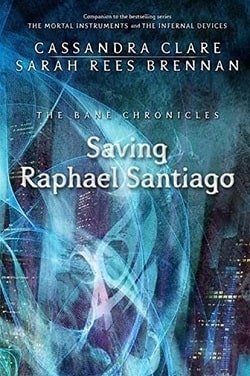Saving Raphael Santiago, the sixth installment of The Bane Chronicles by Cassandra Clare, is a poignant and gripping tale set against the vibrant backdrop of 1950s New York City. This novella not only deepens the lore of the Shadowhunter universe but also explores themes of love, loss, and redemption through the lens of one of its most beloved characters, Magnus Bane. The narrative unfolds as Magnus, the enigmatic warlock, is hired by a distraught mother to find her missing son, Raphael Santiago, a character who has intrigued readers since his introduction in Clare's earlier works.
The story begins with a palpable sense of urgency as Magnus is drawn into the search for Raphael. Clare’s depiction of 1950s Manhattan is rich and immersive, capturing the essence of the era with its unique blend of glamour and grit. The city itself becomes a character, with its bustling streets and hidden corners reflecting the turmoil and hope of its inhabitants. Clare’s attention to detail allows readers to feel the weight of the time period, enhancing the emotional stakes of the narrative.
One of the most striking aspects of this novella is its exploration of parental love and sacrifice. The mother’s desperation to find her son serves as a powerful motivator for Magnus, who understands the depths of a parent’s love all too well. This theme resonates deeply, as it mirrors the struggles of many characters within Clare’s universe, where familial bonds often come with complex challenges. The emotional depth of the mother’s character adds layers to the story, making it not just a quest for a missing person but a journey into the heart of what it means to care for someone deeply.
As Magnus embarks on his search, readers are treated to a rich tapestry of character development. Magnus himself is a multifaceted character, embodying both strength and vulnerability. His interactions with other characters reveal his deep-seated fears and insecurities, particularly regarding his own past and the relationships he has forged over the years. Clare masterfully balances Magnus’s witty, flamboyant exterior with moments of introspection, allowing readers to connect with him on a more profound level.
Raphael Santiago, though initially absent, is brought to life through the memories and stories shared by those who care for him. His character is steeped in mystery, and as Magnus delves deeper into the search, the layers of Raphael’s personality begin to unfold. Clare’s ability to create a sense of urgency around Raphael’s fate keeps readers on the edge of their seats, questioning whether he can be saved and what that salvation might entail.
The novella also touches on the theme of identity, particularly in the context of the societal norms of the 1950s. Raphael’s struggles with his own identity and the expectations placed upon him resonate with contemporary issues of self-acceptance and belonging. Clare’s nuanced portrayal of these themes invites readers to reflect on their own experiences and the societal pressures that shape their identities.
Moreover, the relationship between Magnus and Raphael is central to the narrative. As Magnus uncovers the truth about Raphael’s disappearance, he is forced to confront his own feelings of helplessness and the limitations of his powers. This internal conflict adds depth to Magnus’s character, making his journey not just about finding Raphael but also about understanding his own capacity for love and sacrifice. The emotional stakes are high, and Clare expertly weaves tension and tenderness throughout their connection.
The pacing of the novella is well-crafted, with a balance of action and introspection that keeps readers engaged. Clare’s writing style is both lyrical and accessible, making it easy to become immersed in the story. The dialogue is sharp and witty, filled with the trademark humor that fans of Magnus Bane have come to love. Yet, it is the quieter moments of reflection that linger long after the final page is turned, showcasing Clare’s ability to evoke deep emotional responses from her readers.
In comparison to other works within the Shadowhunter universe, Saving Raphael Santiago stands out for its focus on the emotional and psychological aspects of its characters. While other stories may delve into epic battles and grand quests, this novella hones in on the intimate struggles of its characters, making it a refreshing addition to the series. It echoes the themes found in works by authors like Sarah J. Maas and Holly Black, who also explore complex relationships and the intricacies of identity, but Clare’s unique voice and perspective set this story apart.
Ultimately, Saving Raphael Santiago is a testament to the enduring power of love and the lengths one will go to for those they care about. It challenges readers to consider the nature of sacrifice and the importance of connection in a world that often feels isolating. Clare’s ability to blend fantasy with real-world issues makes this novella not only a compelling read but also a thought-provoking exploration of the human experience.
In conclusion, Saving Raphael Santiago is a beautifully crafted novella that enriches the Shadowhunter universe while offering a poignant exploration of love, identity, and redemption. With its engaging characters, evocative setting, and emotional depth, it is a must-read for fans of Cassandra Clare and newcomers alike. This story will resonate with anyone who has ever fought for someone they love, making it a timeless addition to the canon of young adult literature.
























Reviews 0
Post a Reviews: